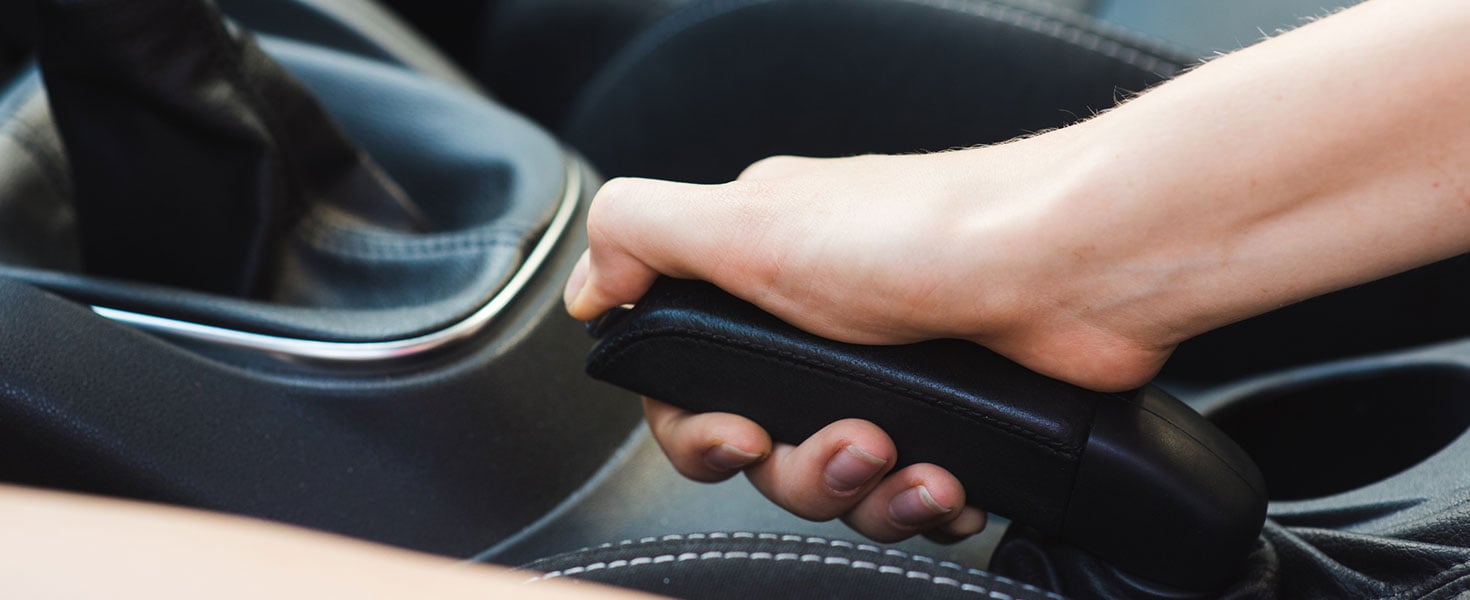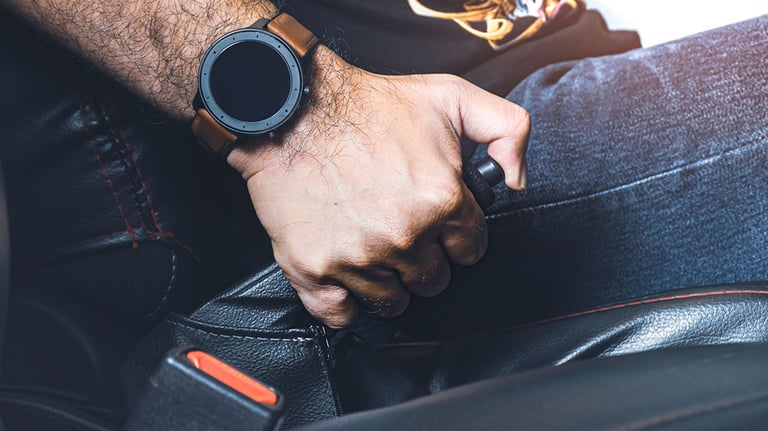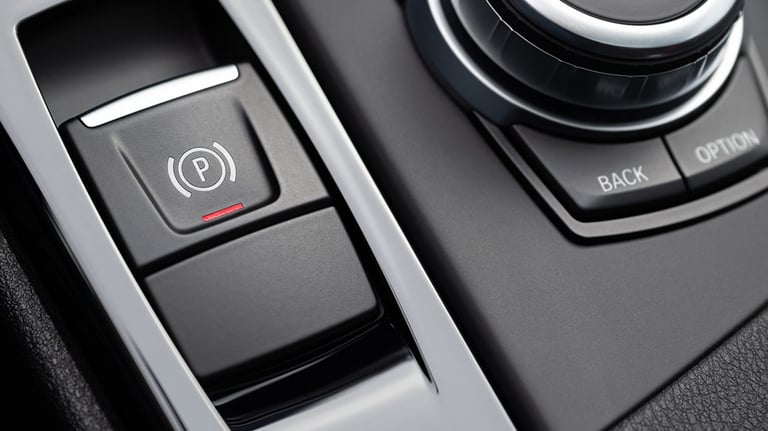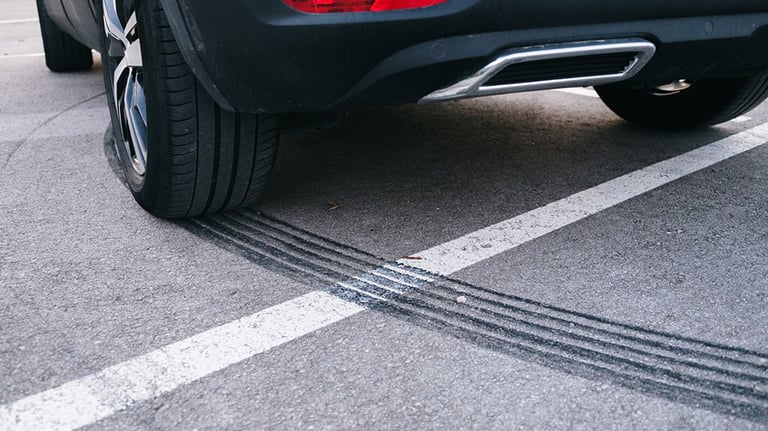Do You Know When to Use Your Emergency Brake?
Not sure when to use the emergency brake? Find out how it works so that you know which situations require the emergency brake


For most drivers, their emergency brake is an afterthought, something to be used only when they park on a hill or steep incline—and nothing more. While emergency brakes—also known as a hand brake, e-brake, or parking brake—do assist drivers parked on inclines, many are surprised to find that experts recommend using the emergency brake whenever you park your car—including on flat, level surfaces.

How is your emergency parking brake different from your regular brakes?
Your regular braking system operates using hydraulic lines filled with brake fluid and needs regular mechanical service to replace worn parts such as pads, rotors, and fluid since the system is used every time you drive. When you depress your brake pedal, pressure is applied to the fluid in your brake lines, magnifying the force of your pedal press and clamping brake calipers down on the wheel rotors to bring the car to a stop.
Originally designed to be a secondary braking system that drivers could use in the event of a primary brake system failure to avoid dangerous car accidents, the “emergency brake” in most cars is operated by wire and is connected to the vehicle’s rear brakes. Drivers use their emergency brake far less often than their primary brakes. Although it does apply less force to the calipers than the primary brakes, the e-brake can stop your car or truck in the event of a brake failure.
Drivers should avoid thinking of their e-brake as an “emergency only” tool, though it is designed to be used in an emergency, of course. Knowing when to use emergency brake and how it can be used is vital to help keep a car stopped and prevent damage to other vehicle components.
Are the emergency brake and parking brake the same thing?
In short, yes, a parking brake and emergency brake are the same thing. Some may be operated by a hand lever or a button, while other vehicles feature a pedal underneath the steering column that can be pressed down and locked into place. In both cases, the function is the same, so don’t let a “parking brake” designation discourage you from using it in the event of an emergency to stop your vehicle.
Does the emergency brake apply to rear wheels only?
In most cases, the car emergency brake only engages with the rear wheels. So, when you only use the emergency brake to slow or stop a vehicle, the rear tires will have less traction than the primary brakes. This is because a slowing vehicle shifts its weight to the front end, loading the suspension up front and giving the front wheels and brakes more stopping traction. By comparison, this same weight shift lightens the load on the rear, extending its suspension and taking weight off the back end, lightening it.
Understanding and knowing the physics of a stopping vehicle is important if you find yourself needing to rely only on your emergency brake to stop.

Why should you use the e-brake whenever you park—even on flat surfaces?
When you put your car in park and take your feet off the pedals, have you ever noticed your vehicle roll slightly before stopping? This is because of the parking pawl in your transmission.
The parking pawl is a small metal component that engages with gears in your transmission to prevent them from moving any time you shift your car into park. So, when you feel your car move slightly after parking and then come to rest, this is your pawl engaging with the gears inside your transmission to keep them stationary.
While the pawl alone can keep your car stationary in most situations, parking without using the parking brake means the entire weight of your vehicle is resting on the pawl and gears inside your transmission. Manufacturers and auto mechanics advise drivers to always engage the e-brake before shifting their vehicle into park to prevent wear and tear on intricate vehicle components.
Repeatedly using only the pawl, especially when parked on an incline, rests the entire weight of the parked vehicle on the parking pawl and the components within the vehicle’s transmission. If the car is struck by another vehicle or simply parked on steep hills repeatedly, undue wear and tear on your internal transmission components and engine can occur over time, leading to expensive repairs down the road.
It’s wise to get in the habit of engaging your parking brake whenever you park, fully engaging the brake before shifting into park. By taking this small step, you can ensure that the pressure and stresses of your parked vehicles is exerted on the braking system, protecting the delicate components of your transmissions and engines.

Can you use your emergency brake to stop?
Yes, in fact, this is why it’s called the “emergency brake” in the first place. You can use the emergency brake to bring your car to a stop in the event of a failure in the primary system, but take care in how the e-brake is applied. Should you find yourself needing to use the emergency brake to stop, smooth inputs will be key to keep the vehicle from locking its wheels and skidding out of control. Apply enough pressure on the e-brake to slow the vehicle down while maintaining control and avoiding skidding the tires.
How do you use your emergency brake in an emergency?
There are few more dire driving situations than a primary braking system failure when your vehicle is in motion. In the event of an emergency, drivers should resist the urge to yank or fully engage their emergency brake right away as this could lock the rear wheels of the vehicle, sending it into an uncontrollable skid.
Rather, you should take your foot off the gas pedal and gradually engage the emergency brake, slowing the vehicle to a stop. Doing so will help you maintain control of the vehicle while also ensuring that the wheels of the vehicle don’t lock into a dangerous slide.
Should you use the e-brake when you change a tire?
Yes, it’s a good idea to use the emergency brake when changing any tire, even the rear. With the emergency brake engaged and at least one rear tire on the ground, your vehicle won’t be able to roll off the jack, making the entire tire changing process that much safer.
Additionally, if you are changing a rear tire with the e-brake engaged, it also keeps the wheel from rolling, which makes it easier to loosen and tighten lug nuts.
Is there a time when you shouldn’t use your emergency brake?
Drivers should take care not to use the emergency brake while driving. This may seem like a no-brainer, but sometimes it’s easy to forget to disengage the parking brake. If you continue to operate their vehicle with the e-brake engaged, heat can build up in the rotors and calipers, which will eventually spread to the brake lines and fluid inside, bringing the brake fluid to a boil. Boiling brake fluid usually results in a catastrophic failure of the primary braking system.
Drivers should also resist the urge to use the emergency brake during an ice, a snow, or a rain emergency, as slick conditions increase the risks of your vehicle’s wheels locking up, causing you to lose control of your vehicle.
Also keep in mind that the emergency brake operates by wire, not hydraulics like your primary braking system. This means that in below-freezing weather, your e-brake cables may freeze or lock up.
The importance of your vehicle’s emergency brake clearly goes far beyond keeping your car put on inclines. Remember to use this vital brake to ensure your safety as well as extend your vehicle’s lifespan.
